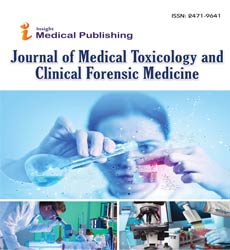Heavy Metal Poisoning and Its Forensic Significance: Linking Environmental Exposure to Clinical Outcomes
Miguel Alvarez
Department of Clinical Toxicology, National Autonomous University of Mexico, Mexico City, Mexico
Published Date: 2025-02-28DOI10.36648/ 2471-641.11.1.159
Received date: February 03, 2025, Manuscript No. ipjmtcm-25-20808; Editor assigned date: February 05, 2025, Pre QC No. ipjmtcm-25-20808 (PQ); Reviewed date: February 17, 2025, QC No. ipjmtcm-25-20808; Revised date: February 22, 2025, Manuscript No. ipjmtcm-25-20808 (R); Published date: February 28, 2025, DOI: 10.36648/ 2471-641.11.1.159.
Citation: Alvarez M (2025) Heavy Metal Poisoning and Its Forensic Significance: Linking Environmental Exposure to Clinical Outcomes. J Med Toxicol Clin Forensic: Vol.11 No. 1:159.
Introduction
Heavy metals such as lead, mercury, arsenic, cadmium, and thallium have long been recognized as potent toxicants with the ability to cause acute and chronic poisoning. Their persistence in the environment, widespread industrial use, and bioaccumulative nature make them a continuing threat to human health. From a clinical perspective, heavy metal poisoning can result in multi-organ dysfunction with subtle, often nonspecific symptoms. Forensic medicine plays a crucial role in linking environmental exposure to toxicological findings, determining cause of illness or death, and assigning responsibility in cases of accidental, occupational, or intentional poisoning. Heavy metals enter the environment through natural and anthropogenic processes, including mining, smelting, pesticide use, contaminated water sources, and industrial waste disposal. Lead contamination is often linked to paints, batteries, and drinking water pipelines. Mercury exposure arises from fish consumption and industrial emissions, while arsenic contamination of groundwater affects millions worldwide. Cadmium and thallium are encountered in occupational settings, with cadmium linked to mining and fertilizers, and thallium sometimes used in rodenticides [1].
Description
The toxic effects of heavy metals stem from their ability to bind to sulfhydryl groups, displace essential metals in enzymes, and generate reactive oxygen species. Lead interferes with heme synthesis and disrupts neurotransmission, while mercury induces oxidative stress and neuronal degeneration. Arsenic impairs mitochondrial function, affecting energy metabolism, and cadmium causes renal tubular damage and bone demineralization. Thallium exerts neurotoxic effects by disrupting potassium-dependent processes. These mechanisms underline the multi-systemic nature of heavy metal poisoning, often leading to overlapping clinical features [2].
In children, even low levels of exposure can result in developmental delay and behavioral disorders. Mercury poisoning presents with tremors, gingivitis, memory disturbances, and, in severe cases, renal and pulmonary failure. Prenatal mercury exposure can cause congenital malformations and neurological deficits. Clinically, these conditions may mimic other diseases, necessitating a high index of suspicion and confirmatory toxicological testing [3].
Arsenic poisoning may be acute, producing gastrointestinal distress, cardiovascular collapse, and multi-organ failure, or chronic, leading to hyperpigmentation, keratosis, peripheral neuropathy, and increased cancer risk. Cadmium exposure is insidious, with cumulative renal tubular damage, osteoporosis, and pulmonary emphysema being characteristic outcomes. Both arsenic and cadmium are classified as Group 1 carcinogens by the International Agency for Research on Cancer (IARC), highlighting their long-term health consequences [4].
Though less common, thallium poisoning is of particular forensic interest due to its history of use in homicidal poisoning. Clinical features include alopecia, painful neuropathy, gastrointestinal upset, and multi-organ failure. Its colorless, tasteless properties make it difficult to detect in food or beverages, adding to its notoriety as a â??poisonerâ??s poison.â?ÃÂ Forensic toxicologists rely on hair and nail analysis, where thallium is deposited, to confirm exposure in suspicious cases. In forensic medicine, heavy metal poisoning requires a multidisciplinary approach combining clinical history, autopsy findings, environmental investigation, and toxicological analysis. Autopsy features may include organ congestion, gastrointestinal erosions, neuropathological changes, and in chronic cases, characteristic pigmentation. Biological specimens such as blood, urine, hair, nails, and organ tissues are analyzed using sensitive methods including Atomic Absorption Spectrometry (AAS), Inductively Coupled Plasma Mass Spectrometry (ICP-MS), and X-ray fluorescence spectroscopy [5].
Conclusion
Heavy metal poisoning exemplifies the intricate link between environmental exposure, clinical outcomes, and forensic significance. From chronic low-dose exposures causing subtle health effects to acute lethal intoxications, heavy metals present a spectrum of challenges for clinicians and forensic experts alike. Advances in analytical chemistry have significantly improved detection and interpretation, enhancing the reliability of medico-legal conclusions. Yet, challenges remain in differentiating toxic from incidental exposure and in addressing the broader public health implications of environmental contamination. A comprehensive, multidisciplinary approach involving clinicians, toxicologists, environmental scientists, and legal authorities is essential for effective management and prevention of heavy metal poisoning.
Acknowledgement
None.
Conflict of Interest
None.
References
- Pal A, Sk MP, Chattopadhyay A. (2016). Conducting carbon dot–polypyrrole nanocomposite for sensitive detection of picric acid. ACS Appl Mater Interfaces8: 5758-5762.
Google Scholar Cross Ref Indexed at
- Gupta A, Chaudhary A, Mehta P, Dwivedi C, Khan S, et al. (2015). Nitrogen-doped, thiol-functionalized carbon dots for ultrasensitive Hg (II) detection. Chem Comm51: 10750-10753.
Google Scholar Cross Ref Indexed at
- Lim KT, Liu H, Liu Y, Yang JK. (2019). Holographic colour prints for enhanced optical security by combined phase and amplitude control. Nat Commun10: 25.
Google Scholar Cross Ref Indexed at
- Sun T, Xu B, Chen B, Chen X, Li M, et al. (2017). Anti-counterfeiting patterns encrypted with multi-mode luminescent nanotaggants. Nanoscale9: 2701-2705.
Google Scholar Cross Ref Indexed at
- Liu Y, Han F, Li F, Zhao Y, Chen M, et al. (2019). Inkjet-printed unclonable quantum dot fluorescent anti-counterfeiting labels with artificial intelligence authentication. Nat Commun10: 2409.

Open Access Journals
- Aquaculture & Veterinary Science
- Chemistry & Chemical Sciences
- Clinical Sciences
- Engineering
- General Science
- Genetics & Molecular Biology
- Health Care & Nursing
- Immunology & Microbiology
- Materials Science
- Mathematics & Physics
- Medical Sciences
- Neurology & Psychiatry
- Oncology & Cancer Science
- Pharmaceutical Sciences
